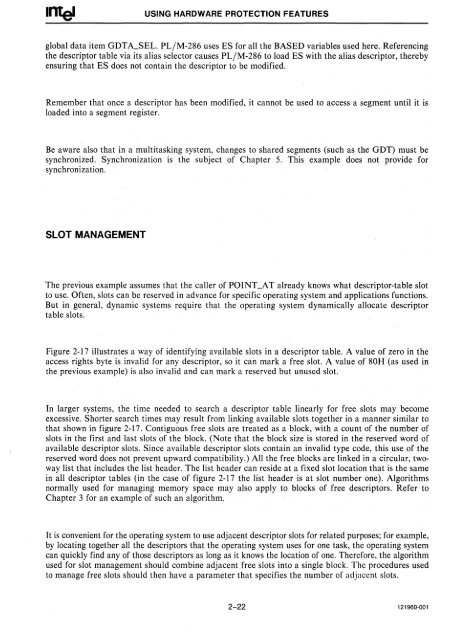iAPX 286 Operating System Writers Guide 1983
iAPX 286 Operating System Writers Guide 1983
iAPX 286 Operating System Writers Guide 1983
You also want an ePaper? Increase the reach of your titles
YUMPU automatically turns print PDFs into web optimized ePapers that Google loves.
IntelUSING HARDWARE PROTECTION FEATURESglobal data item GDTILSEL. PL/M-<strong>286</strong> uses ES for all the BASED variables used here. Referencingthe descriptor table via its alias selector causes PL/M-<strong>286</strong> to load ES with the alias descriptor, therebyensuring that ES does not contain the descriptor to be modified.Remember that once a descriptor has been modified, it cannot be used to access a segment until it isloaded into a segment register.Be aware also that in a multitasking system, changes to shared segments (such as the GDT) must besynchronized. Synchronization is the subject of Chapter 5. This example does not provide forsynchronization.SLOT MANAGEMENTThe previous example assumes that the caller of POINT_AT already knows what descriptor-table slotto use. Often, slots can be reserved in advance for specific operating system and applications functions.But in general, dynamic systems require that the operating system dynamically allocate descriptortable slots.Figure 2-17 illustrates a way of identifying available slots in a descriptor table. A value of zero in theaccess rights byte is invalid for any descriptor, so it can mark a free slot. A value of 80H (as used inthe previous example) is also invalid and can mark a reserved but unused slot.In larger systems, the time needed to search a descriptor table linearly for free slots may becomeexcessive. Shorter search times may result from linking available slots together in a manner similar tothat shown in figure 2-17. Contiguous free slots are treated as a block, with a count of the number ofslots in the first and last slots of the block. (Note that the block size is stored in the reserved word ofavailable descriptor slots. Since available descriptor slots contain an invalid type code, this use of thereserved word does not prevent upward compatibility.) All the free blocks are linked in a circular, twowaylist that includes the list header. The list header can reside at a fixed slot location that is the samein all descriptor tables (in the case of figure 2-17 the list header is at slot number one). Algorithmsnormally used for managing memory space may also apply to blocks of free descriptors. Refer toChapter 3 for an example of such an algorithm.It is convenient for the operating system to use adjacent descriptor slots for related purposes; for example,by locating together all the descriptors that the operating system uses for one task, the operating systemcan quickly find any of those descriptors as long as it knows the location of one. Therefore, the algorithmused for slot management should combine adjacent free slots into a single block. The procedures usedto manage free slots should then have a parameter that specifies the number of adjacent slots.2-22 121960·001
















